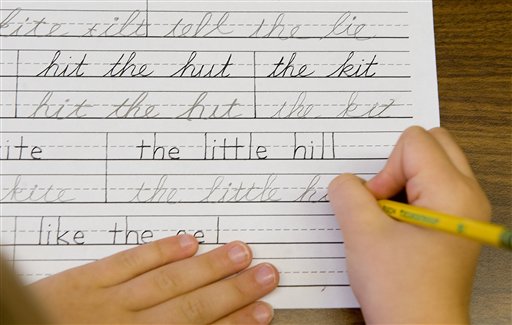It’s a trademark of you. A glimpse of your personality. But in today’s day and age, the phrase, “Give me your John Hancock!” is a lost art form.
Your signature could be one of the most important things that sets you apart from the person standing next to you – yet some high school students still have trouble signing their name on documents as crucial as college applications and as trivial as signing a birthday card.
In the fall, Juniors across America sign up to take the PSATs. Before the test starts, all students must write out a statement declaring that they will not cheat or alter their answers after finishing each section. This statement, however, must be written in cursive, which takes a minimum of fifteen minutes for all students to transcribe.
Many instructors feel the need to write the statement out on the board so students can model their writing after it. Other teachers, however, believe it is ridiculous that kids cannot write in cursive, making the students fend for themselves with no example of the cursive to follow.
Kyle Berger, English and Journalism teacher at North Penn High School, feels for the students who believe cursive is strenuous to write.
“I remember in elementary school we were graded on handwriting. I don’t know if they still do that or not, but I always got a bad grade on it,” said Berger.
He mentioned the practice exam that he had to take to become a teacher, explaining how he had to write out a statement in cursive similar to the one on the PSATs.
“I had to sit and think how to write in cursive. So I don’t know that it’s ridiculous; I think you should just be able to sign your name,” said Berger. The English teacher even went on to say that penmanship is not necessarily the most important skill that can be taught to students. “I still think there’s a place for it, though, because at some point you’re going to have to be able to sign your name so people can understand it.”
Some North Penn students would take a strong liking to this statement. Victoria Horrell, a senior at North Penn, surely would. “It wastes too much time. I think it’s hard to read someone’s cursive, making it unnecessary in school.”
Clemson University Freshman Allie Freed agreed with the negative opinion of cursive.
“I don’t even know how to write cursive anymore,” said Freed, laughing. “From my experience, in college and even high school, all teachers want you to do is type, so I think that cursive isn’t needed anymore.”
Because the foundation of cursive is taught in elementary school, the teachers of these schools have strong feelings toward the subject.
Brynn Hoffman, a fourth grade teacher at Inglewood Elementary school, feels that at this point in a child’s life, it is a good time developmentally to use hand muscles in ways other than printing. “It activates a different part of the brain than regular printing does. Cursive writing actually furthers fine motor skill development. Cursive can help students with disabilities too. It gives them a chance to see letters in a different, artistic way.”
She also added that cursive is often demanded in the real world. “Future employers might use cursive and expect others to use it as well. It is necessary to read handwritten words, and it shows that you take pride in your work and thoughts,” said Hoffman.
The fourth grade teacher also added, smiling, that “there is nothing better than receiving a handwritten note in beautiful cursive penmanship!”
When students initially learn cursive, there is great emphasis on its frequent use from the teachers instructing it, though as the students grow and move on to high school and college, it is not shown as much attention. Various teachers and students alike put it on the back burner, saving it only for times when a signature is required. Ultimately, the question is: how often will using cursive really be necessary?
The one thing we know for sure is that the world will always need cursive – if nothing else, for that all-powerful and imperative personal signature.


